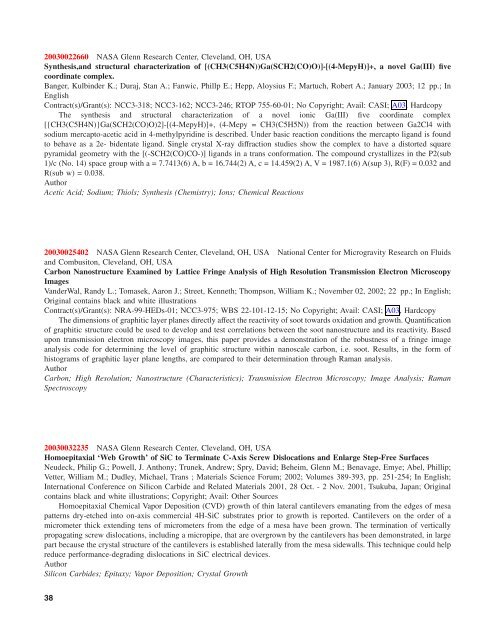Create successful ePaper yourself
Turn your PDF publications into a flip-book with our unique Google optimized e-Paper software.
20030022660 NASA Glenn Research Center, Cleveland, OH, USA<br />
Synthesis,and structural characterization of [(CH3(C5H4N))Ga(SCH2(CO)O)]-[(4-MepyH)]+, a novel Ga(III) five<br />
coordinate complex.<br />
Banger, Kulbinder K.; Duraj, Stan A.; Fanwic, Phillp E.; Hepp, Aloysius F.; Martuch, Robert A.; January 2003; 12 pp.; In<br />
English<br />
Contract(s)/Grant(s): NCC3-318; NCC3-162; NCC3-246; RTOP 755-60-01; No Copyright; Avail: CASI; A03, Hardcopy<br />
The synthesis and structural characterization of a novel ionic Ga(III) five coordinate complex<br />
[{CH3(C5H4N)}Ga(SCH2(CO)O)2]-[(4-MepyH)]+, (4-Mepy = CH3(C5H5N)) from the reaction between Ga2Cl4 with<br />
sodium mercapto-acetic acid in 4-methylpyridine is described. Under basic reaction conditions the mercapto ligand is found<br />
to behave as a 2e- bidentate ligand. Single crystal X-ray diffraction studies show the complex to have a distorted square<br />
pyramidal geometry with the [(-SCH2(CO)CO-)] ligands in a trans conformation. The compound crystallizes in the P2(sub<br />
1)/c (No. 14) space group with a = 7.7413(6) A, b = 16.744(2) A, c = 14.459(2) A, V = 1987.1(6) A(sup 3), R(F) = 0.032 and<br />
R(sub w) = 0.038.<br />
Author<br />
Acetic Acid; Sodium; Thiols; Synthesis (Chemistry); Ions; Chemical Reactions<br />
20030025402 NASA Glenn Research Center, Cleveland, OH, USA National Center for Microgravity Research on Fluids<br />
and Combusiton, Cleveland, OH, USA<br />
Carbon Nanostructure Examined by Lattice Fringe Analysis of High Resolution Transmission Electron Microscopy<br />
Images<br />
VanderWal, Randy L.; Tomasek, Aaron J.; Street, Kenneth; Thompson, William K.; November 02, 2002; 22 pp.; In English;<br />
Original contains black and white illustrations<br />
Contract(s)/Grant(s): NRA-99-HEDs-01; NCC3-975; WBS 22-101-12-15; No Copyright; Avail: CASI; A03, Hardcopy<br />
The dimensions of graphitic layer planes directly affect the reactivity of soot towards oxidation and growth. Quantification<br />
of graphitic structure could be used to develop and test correlations between the soot nanostructure and its reactivity. Based<br />
upon transmission electron microscopy images, this paper provides a demonstration of the robustness of a fringe image<br />
analysis code for determining the level of graphitic structure within nanoscale carbon, i.e. soot. Results, in the form of<br />
histograms of graphitic layer plane lengths, are compared to their determination through Raman analysis.<br />
Author<br />
Carbon; High Resolution; Nanostructure (Characteristics); Transmission Electron Microscopy; Image Analysis; Raman<br />
Spectroscopy<br />
20030032235 NASA Glenn Research Center, Cleveland, OH, USA<br />
Homoepitaxial ‘Web Growth’ of SiC to Terminate C-Axis Screw Dislocations and Enlarge Step-Free Surfaces<br />
Neudeck, Philip G.; Powell, J. Anthony; Trunek, Andrew; Spry, David; Beheim, Glenn M.; Benavage, Emye; Abel, Phillip;<br />
Vetter, William M.; Dudley, Michael, Trans ; Materials Science Forum; 2002; Volumes 389-393, pp. 251-254; In English;<br />
International Conference on Silicon Carbide and Related Materials 2001, 28 Oct. - 2 Nov. 2001, Tsukuba, Japan; Original<br />
contains black and white illustrations; Copyright; Avail: Other Sources<br />
Homoepitaxial Chemical Vapor Deposition (CVD) growth of thin lateral cantilevers emanating from the edges of mesa<br />
patterns dry-etched into on-axis commercial 4H-SiC substrates prior to growth is reported. Cantilevers on the order of a<br />
micrometer thick extending tens of micrometers from the edge of a mesa have been grown. The termination of vertically<br />
propagating screw dislocations, including a micropipe, that are overgrown by the cantilevers has been demonstrated, in large<br />
part because the crystal structure of the cantilevers is established laterally from the mesa sidewalls. This technique could help<br />
reduce performance-degrading dislocations in SiC electrical devices.<br />
Author<br />
Silicon Carbides; Epitaxy; Vapor Deposition; Crystal Growth<br />
38
















